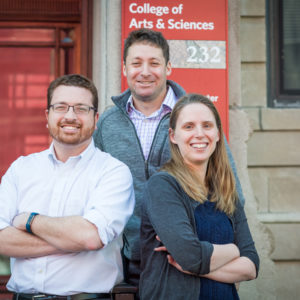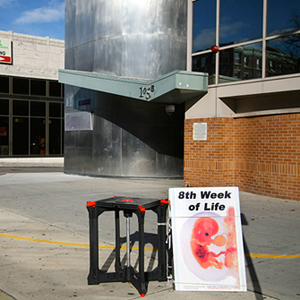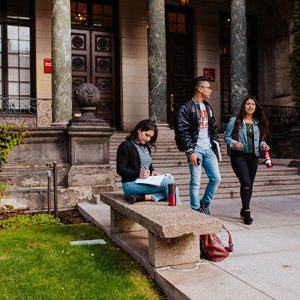Chimps and Their Rights
Animal rights champions argue that chimpanzees and other creatures should have rights similar to those of humans (“Nonhuman Rights: Is It Time to Unlock the Cage?” Summer 2017). The trouble with this is, only humans have rights. As School of Law and other alumni may recall from Get to Know Your Constitution Week, which we experienced at LAW in 1967, the preamble to the Constitution, the first amendment and the ninth amendment, and all the Constitution refer to rights of the people. Not animals. You can call a chimpanzee a person, you can compare a chimpanzee to a person, and you can say a primate has emotions like a person, but it is not a person. It is an animal. No cite needed.
The deeper trouble here is that the management of animals is a matter of legislation, not judicial action pressed by lawyers, no matter how wise. (Couldn’t resist the pun.) The concept of common law does not preempt the Constitution, the supreme law of the land, and the Constitution, in Article I, Section 1, no less, awards all legislative power to the legislature, not to individual lawyers and courts. The states are bound by the same restrictions because the states have to have a republican form of government, which means all states have to have a division of power among an executive, a legislature, and courts. These are deep topics and there is not total agreement with me on these issues.
Management of animals is important to our economy and our survival as…persons. On the other hand, there should be ethical boundaries to our treatment of animals, with regard to confinement, pain, and more. As animal rights activist Steven Wise (LAW’76) points out, animals have pain and feelings just as we do. But the people, acting through the legislature and considering all of the medical and economic and ethical issues, have to decide how to treat animals. Democracy now.
Roger B. Ley (LAW’70)
Astoria, Ore.
After reading “Nonhuman Rights: Is It Time to Unlock the Cage?” we immediately thought of a poem our father wrote regarding human decisions and animal sensitivity, called “Professor Noodle and the Monkey.” Although our dad has since passed away, he would be honored that the poem, supporting kind treatment of all living species, be shared with your alumni, including Herbert Glick (MET’79) and Julie Glick (SPH’06).
Professor Noodle and the Monkey
Professor Noodle was the smartest man on earth
Yet the monkey was determined to debate him
To prove that man himself had little worth
And the monkey would eventually outrate him.
Well, Professor Noodle said, now listen up, ape
I will prove that man has put the world in tip-top shape.
Who invented the wheel, who drives the automobile
The monkey or the man?
Who cooks luscious food, changes clothes to his mood
The monkey or the man?
Who’s the ruler of this earth, all its treasures and its worth
The monkey or the man?
Who’s exploring outer space, who will win the final race
Not the monkey, but the man.
The monkey scratched his head, and then replied,
Though it’s true, we’re in the zoo, it’s men like you
Who should really be inside.
For this is my philosophy, the monkey said,
Man thinks he’s brilliant, but he’s too soon dead
Better to be a monkey and to live in peace
Than man who’s so smart that the world may cease.
Who gets killed in the fight where each side says he’s right
The monkey or the man?
Who has more than he can eat, yet starves his brother across the street
The monkey or the man?
Who drops bombs that kill and maim, yet says he’s free from any blame
The monkey or the man?
Who tries to reach a star, but on earth he won’t go far
Not the monkey, but the man.
Professor Noodle, who’s the smartest man on earth,
Said, I guess you proved what man is really worth
So wait until I put my books and papers back upon the shelf
And then I’ll join you, because it’s sad but true
That man has made a monkey of himself,
Yes, man has made a monkey of himself.
Elaine Simmons Glick and Family
Sharon, Mass.
A More Colorful Place
Kudos to Daria Lugina (CFA’19, CAS’19) for her delightful idea to paint the doors of 200 Bay State Road with brightly painted characters (“Bringing Whimsy to Bay State Road,” Summer 2017). I lived there from fall 1967 to spring 1969. Back then, Bay State Road was a more colorful place, with brightly painted front doors on some buildings and fraternity flags hanging from others. On a visit to campus several years ago, I was saddened to see that Bay State Road was, frankly, too homogeneous in appearance. I missed the character the street had in the late ’60s.
Barbara Strauss Neuerman (CAS’71)
Marietta, Ga.
African American Heroines
I appreciated reading Sara Rimer’s article on Ashley Farmer’s work plus her upcoming book (“Behind the Black Power Movement,” Summer 2017). And I’m letting other folks know about it as well here in Portland, Ore. Thank you.
Mark Alter (SSW’81)
Portland, Ore.
















































With all due respect to Roger Ley, Humans are in fact animals. To continue the folly of distinguishing between people and animals as if humans are not animals is to ignore scientific fact and to perpetuate the misguided and consequential error of human supremacy, which is leading us headlong into ecological (and moral) collapse.
Also, evidence show that nonhuman animals are not so different from humans. Ducklings have abstract thoughts, rats have empathy, and fish feel pain. We are entering the post humanist era in this Anthropocene Epoch, and perhaps one of the greatest realizations for the species in its history is that all life is one, and humans are not above any of it. Strict humanism has had its day,